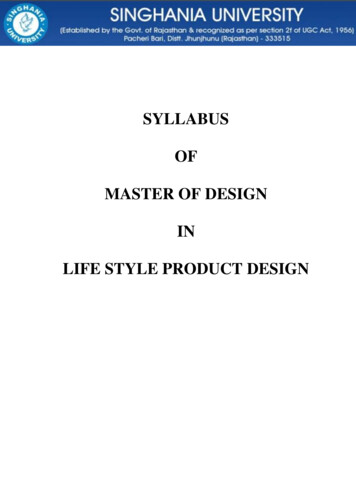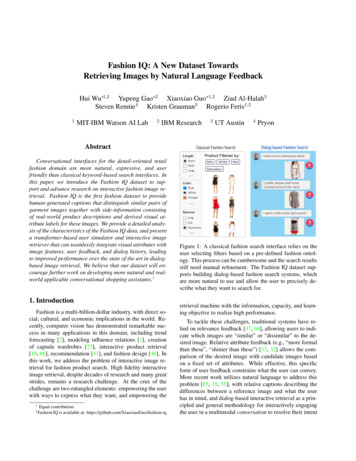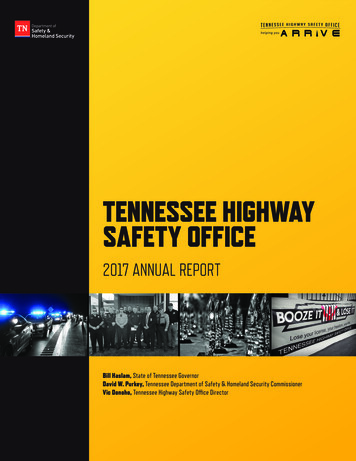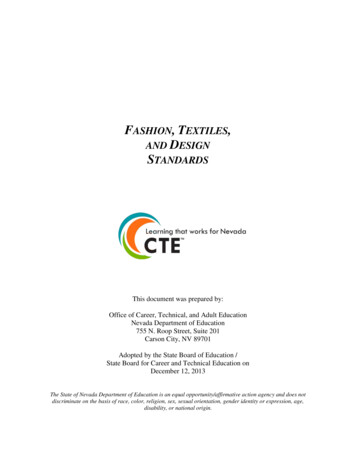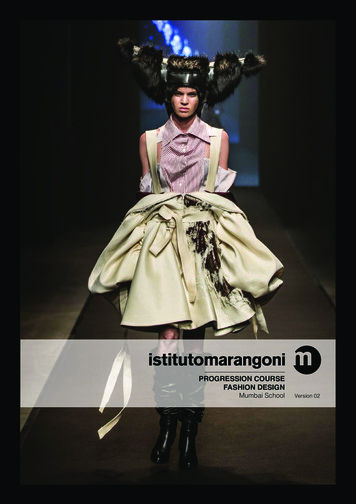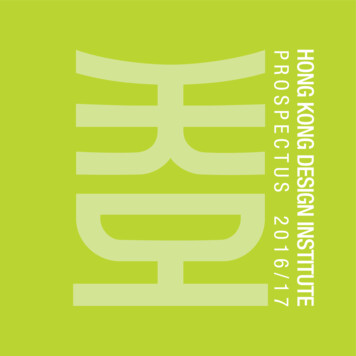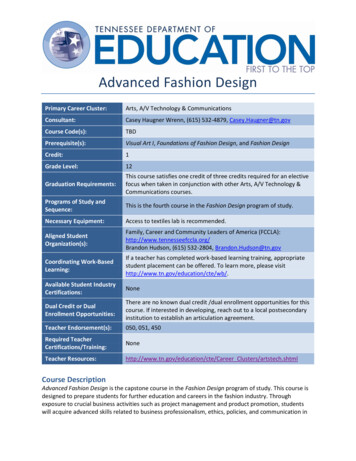
Transcription
Advanced Fashion DesignPrimary Career Cluster:Arts, A/V Technology & CommunicationsConsultant:Casey Haugner Wrenn, (615) 532-4879, Casey.Haugner@tn.govCourse Code(s):TBDPrerequisite(s):Visual Art I, Foundations of Fashion Design, and Fashion DesignCredit:1Grade Level:12Graduation Requirements:This course satisfies one credit of three credits required for an electivefocus when taken in conjunction with other Arts, A/V Technology &Communications courses.Programs of Study andSequence:This is the fourth course in the Fashion Design program of study.Necessary Equipment:Access to textiles lab is recommended.Aligned StudentOrganization(s):Family, Career and Community Leaders of America (FCCLA):http://www.tennesseefccla.org/Brandon Hudson, (615) 532-2804, Brandon.Hudson@tn.govCoordinating Work-BasedLearning:If a teacher has completed work-based learning training, appropriatestudent placement can be offered. To learn more, please visithttp://www.tn.gov/education/cte/wb/.Available Student IndustryCertifications:NoneDual Credit or DualEnrollment Opportunities:There are no known dual credit /dual enrollment opportunities for thiscourse. If interested in developing, reach out to a local postsecondaryinstitution to establish an articulation agreement.Teacher Endorsement(s):050, 051, 450Required TeacherCertifications/Training:NoneTeacher Resources:http://www.tn.gov/education/cte/Career Clusters/artstech.shtmlCourse DescriptionAdvanced Fashion Design is the capstone course in the Fashion Design program of study. This course isdesigned to prepare students for further education and careers in the fashion industry. Throughexposure to crucial business activities such as project management and product promotion, studentswill acquire advanced skills related to business professionalism, ethics, policies, and communication in
the fashion industry. In addition, students complete a capstone project during which they will createartifacts to include in a professional portfolio. While not required, student internships can provide analternative route for students to master required course standards. Students who have the opportunityto participate in internships may be responsible for the following tasks: assisting in client presentations,resource updating and vendor management, assisting designers, and participating with design teams.Standards in this course are aligned with Tennessee Common Core State Standards for English LanguageArts & Literacy in Technical Subjects and National Standards for Family and Consumer SciencesEducation, Second Edition.*Program of Study ApplicationThis is the final course in the Fashion Design program of study. For more information on the benefits andrequirements of implementing this program in full, please visit the Arts, A/V Technology andCommunications website at http://www.tn.gov/education/cte/Career Clusters/artstech.shtml.Course StandardsOccupational Safety1) Demonstrate the ability to comply with personal and environmental safety practices associatedwith textile applications: the use of adhesives; hand tools; machines; and the handling, storage,and disposal of chemicals/materials in accordance with local, state, and federal safety andenvironmental regulations.a. Inspect, maintain, and employ safe operating procedures with tools and equipment.b. Adhere to responsibilities, regulations, and Occupational Safety & Health Administration(OSHA) policies regarding reporting of accidents and observed hazards, and regardingemergency response procedures.c. Maintain a portfolio record of written safety examinations and equipment examinationfor which the student has passed an operational checkout by the instructor.(TN CCSS Reading 3, 4; TN CCSS Writing 4; FACS 16)Professionalism and Ethics in Fashion Design2) Collaboratively develop a professionalism rubric with performance indicators for each of thefollowing professional attributes required within the fashion design industry:a. Creative design skillsb. Ethical fashion business practicesc. Honestyd. Respecte. Communicationf. Responsibility(FACS 16)3) Examine the Ethical Trading Initiative (ETI) and summarize its governance, mission, andstrategies. Synthesizing popular commentary and scholarly perspectives on the Initiative and itseffectiveness assess the domestic and global significance and implications of ETI’s Base Code onthe textile industry and clothing market. Apply principles from the ETI Base Code to compose aPage 2
personal code of ethics to follow in the fashion design industry. (TN CCSS Reading 2, 9; TN CCSSWriting 4, 7; FACS 16)4) Examine current and emerging ethical issues related to the fashion design industry (e.g., furdebate, unethical labor practices, and fashion-inspired body-image disorders). Choose one suchissue and develop a claim about its impact on the fashion industry’s image. (TN CCSS Reading 7,8; TN CCSS Writing 1, 4, 9; FACS 16)Project Management5) Interpret and apply basic components of business plans to design and complete acomprehensive business plan for a specific fashion line. Generate formal strategies formarketing, financing, manufacturing, and labor in the context of domestic and global markets.(TN CCSS Reading 7; FACS 16)6) Create an outline that illustrates the basic components of project budgets commonly used infashion design proposals (e.g., itemized budgets, non-itemized budgets, fixed budgets, andflexible budgets). Implement outline components to generate a comprehensive budget for apotential seasonal fashion line. (TN CCSS Reading 3; TN CCSS Writing 4; FACS 16)7) Examine how businesses in the fashion design industry conduct project management processes.Compare and contrast components of project management models gathered from case studiesof major or local designers. Generate a project management template that addresses theobjectives required for organizing and producing a fashion show. (TN CCSS Reading 7, 9; TN CCSSWriting 4, 8; FACS 16)Capstone Project8) Demonstrate the application of advanced fashion design knowledge and skills to create acomprehensive, original fashion line with at least 10 pieces. Incorporate design and fabricationskills, technology applications and market indicators (e.g., trends, forecasting, target markets) toplan, problem-solve, and attain project goals. Project components may include but are notlimited to the following:a. Utilize computer-aided design software to illustrate project elementsb. Create 3-Dimensional models of project elementsc. Select and use appropriate materials and methods to fabricate project appareld. Create a design narrative board using textile samples and fashion sketches(FACS 16)9) Research the effects of brand strategies on creating product identity and enhancing sales.Examine print and digital resources to compare brand strategies used in fashion design; developan original business logo and designer label for the fashion line. (TN CCSS Reading 7; TN CCSSWriting 4, 7; FACS 16)Page 3
10) Summarize the main elements of a promotional mix and examine promotional activities specificto the fashion design industry. Develop and implement a promotional campaign to strategicallyposition and publicize the fashion line. Produce and deliver a technology-enhanced presentationof the promotional plan for the fashion collection that could be translated into a runway fashionshow. (TN CCSS Reading 2; TN CCSS Writing 4, 6; FACS 16)11) Compile important artifacts that represent professional skills and personal style to create aprofessional portfolio and accompanying electronic representation. Develop a plan to distributethe electronic portfolio as part of a career job search and/or as admission to a postsecondarydesign institution. (TN CCSS Reading 1, 8; TN CCSS Writing 4, 9; FACS 16)Internship Option**12) Participate in a work-based learning internship experience to develop, practice, anddemonstrate skills outlined in standards above. Internship should follow current Tennesseework-based learning guidelines as appropriate.13) Create and continually update a personal journal to document internship activities. Drawconnections between the experience and course content, thoughtfully reflecting on:a. Acquired leadership and technical skillsb. Problem-solving techniques and decision-making skillsc. Team member participation in a learning environmentd. Personal career development(TN CCSS Writing 2, 4)14) Upon conclusion of the internship, write an informative essay summarizing the internshipexperience and next steps for personal and professional growth. Produce a technologyenhanced class presentation showcasing highlights, challenges, and lessons learned from theinternship. (TN CCSS Writing 2, 4, 6)** Although a hands-on experience in work-based learning (WBL) is the most ideal, it is recognized thatnot all students will be able to be placed in a working establishment. If a student is placed, then theexperience would follow Tennessee WBL guidelines found online tandards Alignment Notes*References to other standards include: TN CCSS Reading: Common Core State Standards for English Language Arts & Literacy inHistory/Social Studies, Science, and Technical Subjects; Reading Standards for Literacy in Scienceand Technical Subjects 6-12; Grades 11-12 Students (page 62).o Note: While not directly aligned to one specific standard, students who are engaging inactivities outlined above should be able to also demonstrate fluency in Standards 5, 6and 10 at the conclusion of the course. TN CCSS Writing: Common Core State Standards for English Language Arts & Literacy inHistory/Social Studies, Science, and Technical Subjects; Writing Standards for Literacy inPage 4
Page 5History/Social Studies, Science, and Technical Subjects 6-12; Grades 11-12 Students (pages 6466).o Note: While not directly aligned to one specific standard, students who are engaging inactivities outlined above should be able to also demonstrate fluency in Standards 3, 5and 10 at the conclusion of the course.FACS: National Standards for Family and Consumer Sciences Education, Second Edition: NationalAssociation of State Administrators of Family and Consumer Sciences, FACS.P21: Partnership for 21st Century Skills Framework for 21st Century Learningo Note: While not all standards are specifically aligned, teachers will find the frameworkhelpful for setting expectations for student behavior in their classroom and practicingspecific career readiness skills.
Fashion DesignPrimary Career Cluster:Arts, A/V Technology & CommunicationsConsultant:Casey Haugner Wrenn, (615) 532-4879, Casey.Haugner@tn.govCourse Code(s):TBDPrerequisite(s):Visual Art I and Foundations of Fashion DesignCredit:1Grade Level:11Graduation Requirements:This course satisfies one credit of three credits required for an electivefocus when taken in conjunction with other Arts, A/V Technology &Communications courses.Programs of Study andSequence:This is the third course in the Fashion Design program of study.Necessary Equipment:Access to textiles lab is recommended.Aligned StudentOrganization(s):Family, Career and Community Leaders of America (FCCLA):http://www.tennesseefccla.orgBrandon Hudson, (615) 532-2804, Brandon.Hudson@tn.govCoordinating Work-BasedLearning:If a teacher has completed work-based learning training, appropriatestudent placement can be offered. To learn more, please visithttp://www.tn.gov/education/cte/wb/.Available Student IndustryCertifications:NoneDual Credit or DualEnrollment Opportunities:There are no known dual credit /dual enrollment opportunities for thiscourse. If interested in developing, reach out to a local postsecondaryinstitution to establish an articulation agreement.Teacher Endorsement(s):050, 051, 450Required TeacherCertifications/Training:NoneTeacher Resources:http://www.tn.gov/education/cte/Career Clusters/artstech.shtmlCourse DescriptionFashion Design is an applied-knowledge course intended to prepare students to pursue careers in thefashion industry. Building on the knowledge acquired in Foundations of Fashion Design, this courseplaces special emphasis on apparel manufacturing and merchandising, marketing applications, productand service management, and the creation of an original fashion collection. In addition, students will
explore trends in fashion design and engage with industry-specific technologies used to produce avariety of fabrics, garments, and accessories. Standards in this course are aligned with TennesseeCommon Core State Standards for English Language Arts & Literacy in Technical Subjects, TennesseeCommon Core State Standards for Mathematics, and National Standards for Family and ConsumerSciences Education, Second Edition.*Program of Study ApplicationThis is the third course in the Fashion Design program of study. For more information on the benefitsand requirements of implementing this program in full, please visit the Arts, A/V Technology andCommunications website at http://www.tn.gov/education/cte/Career Clusters/artstech.shtml.Course StandardsOccupational Safety1) Demonstrate the ability to comply with personal and environmental safety practices associatedwith textile applications:; the use of adhesives; hand tools; machines; and the handling, storage,and disposal of chemicals/materials in accordance with local, state, and federal safety andenvironmental regulations.a. Inspect, maintain, and employ safe operating procedures with tools and equipment.b. Adhere to responsibilities, regulations, and Occupational Safety & Health Administration(OSHA) policies regarding reporting of accidents and observed hazards, and regardingemergency response procedures.c. Maintain a portfolio record of written safety examinations and equipment examinationfor which the student has passed an operational checkout by the instructor. Compareoccupational safety skills included in the portfolio to safety skills designated in authenticcareer postings.(TN CCSS Reading 3, 4; TN CCSS Writing 4; FACS 16)Merchandising and Promotion2) Evaluate data from multiple sources, including textbooks and fine art books, to support analysisof the psychological characteristics of colors. For example, compare and contrast warm and coolcolor palettes. Craft an argument examining the effects on consumer preferences and buyingtrends when color psychology is employed in the marketing of fashion products. Assess theimplications for the selection of fabrics for apparel and accessory design. (TN CCSS Reading 7, 8;TN CCSS Writing 1, 4, 7, 9; FACS 16)3) Identify fundamental techniques and design concepts of fashion merchandise presentation.Research the influence of visual merchandising on consumer purchase decisions. Create achecklist to appraise visual displays for effective and efficient use of display space, lighting, andmerchandise. Apply principles of visual merchandise organization by creating an originalmerchandise display. (TN CCSS Reading 3; TN CCSS Writing 4, 7; FACS 16)Page 2
4) Design a visual representation of a store layout incorporating aesthetic considerations ofmerchandise, services, and customers. Assess how point of view or purpose of the store layoutaffects content, style, and color choices. Store layout representation could include:a. Freeflow Layoutb. Grid Layoutc. Spine Layoutd. Loop Layoute. Parallel Layout(TN CCSS Reading 6; FAC 16)5) Examine the importance of establishing and maintaining merchandise flow processes andstrategies for successful management of merchandise logistics. Compare and contrast the roleof merchandise flow in evaluating and responding to the needs of the business and consumers.(TN CCSS Reading 9; FACS 16)6) Identify promotion strategies used in the fashion industry for communication of productinformation. Consult sample catalogues, professional commentary, shopping apps, and relatedprint and digital sources to determine the impact of technology and social media on fashionmarketing and promotion. (TN CCSS Reading 7, 9; TN CCSS Writing 8; FACS 16)Product and Service Management7) Categorize types of retail clothing stores based on size, company organization (traditional,catalogue, internet), and range of products (variety or specialized). Examine how these retailstores operate within an integrated supply chain, using software such as Electric Point of Sale(EPSO). Assess how the target population of a store shapes the content and style of the productsit sells. (TN CCSS Reading 2, 7; FACS 16)8) Analyze principles of merchandise planning and buying and explain how they relate to eachother and the fashion industry as a whole. Use merchandise planning software solutions tocoordinate a buying plan that includes the following elements:a. Selection of merchandiseb. Establishment of retail pricesc. Ongoing ordering processesd. Management of supplier relationshipse. Strategic merchandisingf. In-store advertising(TN CCSS Reading 3; FACS 16)Marketing and Trends in Fashion Design9) Identify basic principles of marketing, including but not limited to market analysis, planning,implementation, and control. Create a checklist of common marketing plan components (e.g.,marketing objectives, customer analysis, marketing strategies, and tactics). Evaluate data andconduct an original fashion design analysis for a real or invented clothing line using the fourbasic elements of a fashion marketing plan:a. Product developmentb. PricePage 3
c. Distribution managementd. Promotions and communications(TN CCSS Reading 9; TN CCSS Writing 4, 9; FACS 16)10) Examine components of market analysis and trends research related to fashion design (i.e.,season, target market, colors, fabrics, texture, usage). Analyze how and why individuals, events,and ideas develop and interact to create seasonal fashion trends. Research and interprettechnical data to forecast trends in fashion and identify target markets. (TN CCSS Reading 8; TNCCSS Writing 7, 9; FACS 16)11) Analyze the demographics of target markets to predict consumer requirements andpreferences. Integrate research and analysis data to create original fashion collections fordomestic and global markets using computer-aided design applications. (TN CCSS Reading 8; TNCCSS Writing 7, 9; FACS 16)12) Create a comprehensive seasonal buying plan using industry-related budget designing software.Formulate basic budget functions including the following elements: planning process, buyquantity, and benchmarks for progress evaluation and plan adjustment. (TN CCSS Writing 2; TNCCSS Math N-Q; FACS 16)13) Create a window presentation for a retail store incorporating an original garment design andaccessories. Create modified display options to accommodate different seasons, events, andcustomer demographics. (FACS 16)Creation of Fashion Collection14) Drawing on current and historic trends in the color, texture, and print of fabrics used forgarment designs, develop a collection of apparel and accessories for different lifestyles andseasons using hand sketches or computer-aided design. (FACS 16)15) Justify the use of certain fabrics and trims for the needs of selected target markets and garmentfunctionalities, citing market research or industry journals to support decisions. Analyze howproperties of fabrics affect garment performance and cost. Compose an informativepresentation from textile choices through the product development for a chosen target market.(TN CCSS Reading 1; TN CCSS Writing 1, 2, 4; FACS 16)16) Compile a list of materials required for a presentation board featuring a wide range of materialsamples. Evaluate sample elements to determine the most effective combination for creating acomprehensive fashion collection using a variety of colors, fabrics, sketches, and/or industrysoftware designs. (TN CCSS Reading 2, 7; TN CCSS Writing 4, 8; FACS 16)17) Assemble a presentation board that incorporates a collage of color samples, fabrics, andsketches, mounted with color renderings that logically present a particular fashion collection bycolor or style of design. Create a name for each garment in the collection for tracking andcommunication to potential clients. (FACS 16)Page 4
18) Compose and present a clear and coherent written justification for the presentation board thatexplains the principles of design, choice of samples, and analysis of the fashion collection. (TNCCSS Writing 1, 4; FACS 16)19) Construct one or more garments from one of the student-designed collections developed inprevious standards. Demonstrate basic garment construction skills and techniques, usingsamples provided on the presentation board. Demonstrate proficiency in proper pressing,fitting, alteration, finishing, and embellishment for quality garment construction. Demonstratethe appropriate use, selection, and maintenance of equipment, tools, and sewing supplies forthe construction of apparel. (TN CCSS Reading 3; FACS 16)Standards Alignment Notes*References to other standards include: TN CCSS Reading: Common Core State Standards for English Language Arts & Literacy inHistory/Social Studies, Science, and Technical Subjects; Reading Standards for Literacy in Scienceand Technical Subjects 6-12; Grades 11-12 Students (page 62).o Note: While not directly aligned to one specific standard, students who are engaging inactivities outlined above should be able to also demonstrate fluency in Standards 5, 6and 10 at the conclusion of the course. TN CCSS Writing: Common Core State Standards for English Language Arts & Literacy inHistory/Social Studies, Science, and Technical Subjects; Writing Standards for Literacy inHistory/Social Studies, Science, and Technical Subjects 6-12; Grades 11-12 Students (pages 6466).o Note: While not directly aligned to one specific standard, students who are engaging inactivities outlined above should be able to also demonstrate fluency in Standards 3, 5, 6and 10 at the conclusion of the course. TN CCSS Math: Tennessee Common Core State Standards for Mathematics; Math Standards forHigh School: Number and Quantity (pages 58-83).o Note: The standards in this course are not meant to teach mathematical concepts.However, the concepts referenced above may provide teachers with opportunities tocollaborate with mathematics educators to design project based activities or collaborateon lesson planning. Students who are engaging in activities listed above should be able todemonstrate quantitative reasoning as applied to specific technical concepts. In additionstudents will have the opportunity to practice the habits of mind as described in the eightStandards for Mathematical Practice. FACS: National Standards for Family and Consumer Sciences Education, Second Edition: NationalAssociation of State Administrators of Family and Consumer Sciences, FACS. P21: Partnership for 21st Century Skills Framework for 21st Century Learningo Note: While not all standards are specifically aligned, teachers will find the frameworkhelpful for setting expectations for student behavior in their classroom and practicingspecific career readiness skills.Page 5
Foundations of Fashion DesignPrimary Career Cluster:Arts, A/V Technology & CommunicationsConsultant:Casey Haugner Wrenn, (615) 532-4879, Casey.Haugner@tn.govCourse Code(s):TBDPrerequisite(s):Visual Art ICredit:1Grade Level:10Graduation Requirements:This course satisfies one credit of three credits required for an electivefocus when taken in conjunction with other Arts, A/V Technology &Communications courses.Programs of Study andSequence:This is the second course in the Fashion Design program of study.Necessary Equipment:Access to textiles lab is recommended.Aligned StudentOrganization(s):Family, Career and Community Leaders of America (FCCLA):http://www.tennesseefccla.orgBrandon Hudson, (615) 532-2804, Brandon.Hudson@tn.govCoordinating Work-BasedLearning:If a teacher has completed work-based learning training, appropriatestudent placement can be offered. To learn more, please visithttp://www.tn.gov/education/cte/wb/.Available Student IndustryCertifications:NoneDual Credit or DualEnrollment Opportunities:There are no known dual credit /dual enrollment opportunities for thiscourse. If interested in developing, reach out to a local postsecondaryinstitution to establish an articulation agreement.Teacher Endorsement(s):050, 051, 450Required TeacherCertifications/Training:NoneTeacher Resources:http://www.tn.gov/education/cte/Career Clusters/artstech.shtmlCourse DescriptionFoundations of Fashion Design introduces students to the rich history of the fashion industry and thebasic design principles that are integral to its operation. This course studies the history of the fashionindustry, elements and principles of design, textile history and composition, as well as basic construction
principles. Artifacts will be created for inclusion in a portfolio, which will continue to build throughoutthe program of study. Standards in this course are aligned with Tennessee Common Core StateStandards for English Language Arts & Literacy in Technical Subjects and National Standards for Familyand Consumer Sciences Education, Second Edition.*Program of Study ApplicationThis is the second course in the Fashion Design program of study. For more information on the benefitsand requirements of implementing this program in full, please visit the Arts, A/V Technology andCommunications website at http://www.tn.gov/education/cte/Career Clusters/artstech.shtml.Course StandardsOccupational Safety1) Demonstrate the ability to comply with personal and environmental safety practices associatedwith textile applications: the use of adhesives; hand tools; machines; and the handling, storage,and disposal of chemicals/materials in accordance with local, state, and federal safety andenvironmental regulations.a. Inspect, maintain, and employ safe operating procedures with tools and equipment.b. Adhere to responsibilities, regulations, and Occupational Safety & Health Administration(OSHA) policies regarding reporting of accidents and observed hazards, and regardingemergency response procedures.c. Maintain a record of written safety examinations and equipment examinations forwhich the student has passed an operational checkout by the instructor.(TN CCSS Reading 3, 4; TN CCSS Writing 4; FACS 16)Career Investigation2) Identify and analyze career pathways within the Fashion Design program of study. Citesupporting evidence from multiple sources (such as interviews with fashion design professionalsretrieved from industry magazines) to summarize the essential knowledge and skills required forthese careers. Complete one or more career aptitude surveys, analyze the results, and composean essay describing the relationships between personal career aptitudes and careers in fashiondesign. (TN CCSS Reading 1, 2, 7, 9; TN CCSS Writing 4, 8, 9; FACS 1, 16)3) Compile and analyze real-time and projected labor market data from public sources such as theU.S. Bureau of Labor Statistics to investigate local and regional occupational opportunities andtrends in the fashion design industry. Synthesize collected data to develop a graphic illustrationcomparing occupations by education requirements, job availability, salaries, and benefits. (TNCCSS Reading 2, 7, 9; TN CCSS Writing 4, 8, 9; FACS 16)History and Development of Fashion Design4) Synthesize research from informational texts, including fashion magazines and textbooks, tocreate an annotated timeline or visual graphic emphasizing significant time periods withinfashion design dating from the beginning of civilization to the present. Using descriptive text,Page 2
interpret the cultural, social, economic, and technological factors that have influenced fashiondevelopment and design. (TN CCSS Reading 2, 9; TN CCSS Writing 2, 4, 7, 9; FACS 16)5) Explore theories of fashion dynamics and forecasting, and compose an informative essay thatillustrates the five stages of the fashion cycle concept:a. Introductionb. Rise in popularityc. Peak of popularityd. Decline in popularitye. RejectionInvestigate major paradigms (i.e. Circle, Pendulum) in fashion history and critique whether thefashion cycle model helps explain major paradigm shifts over time. (TN CCSS Reading 9; TN CCSSWriting 2, 4; FACS 16)6) Analyze the importance of clothing and fashion in contemporary society as they relate tocultural, economic, and political realities in a variety of contexts around the globe. Investigatethe influences of modern fashion designers; discuss how a society’s customs and preferencesinfluence what is fashionable to certain populations. Create an informational artifact thatidentifies significant contributions from these designers to the fashion industry. (TN CCSSReading 9; TN CCSS Writing 2, 4, 7; FACS 16)Elements and Principles of Design7) Compare and contrast the elements and principles of design in visual arts and examine theirinterrelationships. Analyze the elements and principles of design in the context of fashion byevaluating their purpose and application in apparel and accessories.Elements:a. Lineb. Shapec. Proportiond. Color theory and basic schemese. TexturePrinciples:a. Unityb. Harmonyc. Formal and informal balanced. Rhythme. Contrastf. Emphasisg. Gradation(FACS 16)8) Analyze the color wheel and apply concepts of color theory to the development of fashion specsfor a real or invented clothing line. Identify techniques that achieve desired hues, values, andintensities. Demonstrate the ability to color mix apparel and accessory samples in various colorsystems. (TN CCSS Reading 3; FACS 16)Page 3
History and Development of Textiles9) Examine the historical development of processes and techniques in textile design andproduction. Using descriptive text, summarize the evolution of trends in textile colors, textures,and prints used in fashion design. Identify textile technologies that have influenced appareldesign, production, merchandising, and sales. (TN CCSS Reading 2; TN CCSS Writing 4; FACS 16)10) Analyze research from multiple sources such as technical jou
Advanced Fashion Design Primary Career Cluster: Arts, A/V Technology & Communications Consultant: Casey Haugner Wrenn, (615) 532-4879, Casey.Haugner@tn.gov Course Code(s): TBD Prerequisite(s): Visual Art I, Foundations of Fashion Design, and Fashion Design Credit: 1 Grade Level: 12 Graduation Requirements: This course satisfies one credit of three credits required for an elective
